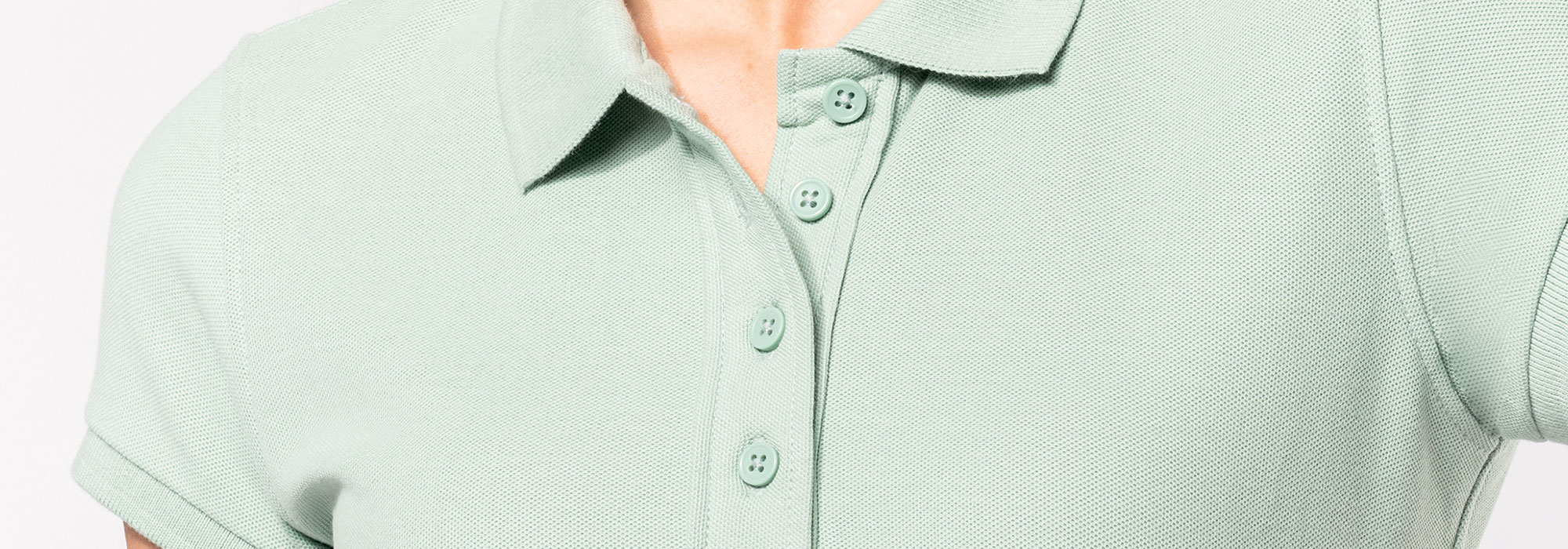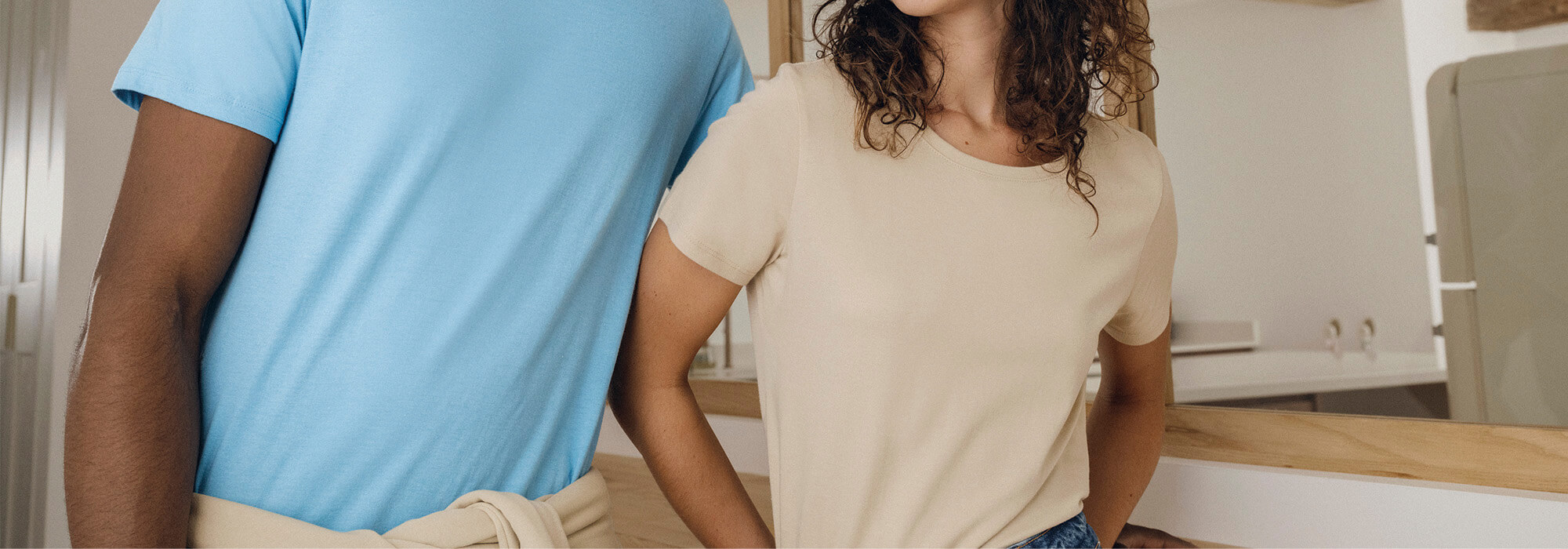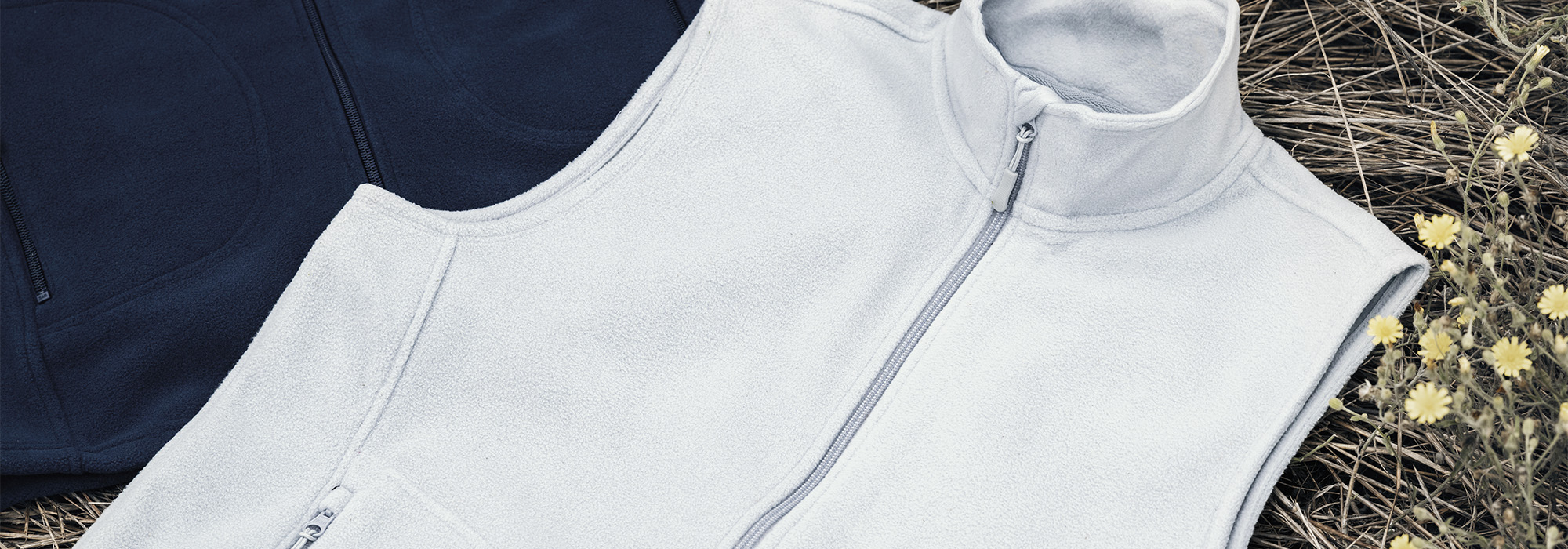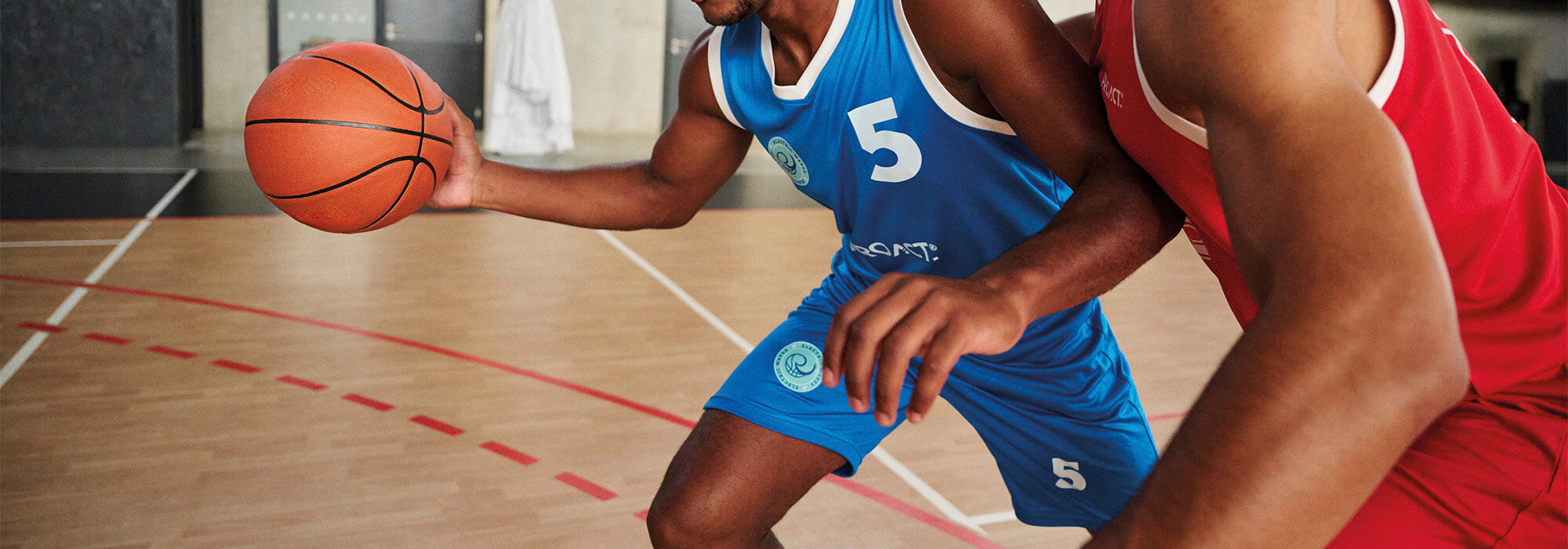Did you know? The invention of the polo shirt dates back to the 1920s. At that time, tennis players wore a shirt and pressed trousers, an outfit that was hardly ergonomic and especially hard to put up with in the heat. This led to the idea of creating a type of short sleeve shirt that would combine comfort and class with being lightweight. After a few adjustments, the polo shirt was born! It quickly became revolutionary with athletes, who were completely convinced that polo shirts offered more freedom of movement than shirts. Added to that its elegance, quality and resistance and the polo became extremely popular, making it a garment of choice in every wardrobe, even corporate ones. It’s the perfect balance between a comfortable and chic outfit that is breathable but smart.
The polo shirt has become one of the must-haves of professional textiles, suitable for a great many industries. It is considered an alternative to the t-shirt, with its shaped collar and placket, which create a sophisticated finish and reflect a neat and professional image.
The hardest wearing styles are also perfectly suited to frequent use and intensive maintenance.
Sales assistants, technicians, mechanics, waiting staff and drivers, polo shirts have won over countless professions thanks to the many options they offer: high visibility, quick drying, anti-bacterial treatments, as well as different colourways and materials, yarn properties and finishes. To help clear things up for you, here are five criteria to consider when choosing the right professional polo shirt.
Criteria #1:
the right material for the right use
Cotton
Let’s start with the most classic and one of the most popular: the cotton polo shirt. And for good reason! 100% cotton is synonymous with resistance, durability and comfort. Our tip? For a good quality textile, look for long fibres that won’t pill, even after several washes. Cotton fibres are also absorbent. This means they have the ability to wick moisture away from the body, such as perspiration, which allows the wearer to stay comfortable even when the textile is damp. A cotton polo shirt is suitable for working indoors and outdoors.
Best for...
physical jobs, in which contact with the customer is important: florist, delivery operative or warehouse manager
Premium version cotton
For more prestigious products, aimed at certain service companies or clothing boutiques, premium cotton is more suitable than classic cotton. This is especially true of Supima® cotton, woven from Pima cotton grown in America (California and Texas to be precise). This variety of cotton only grows there, making it a rare material synonymous with exceptional quality.
Best for...
high-quality outfits, for example in the hospitality, catering and beauty industries, or for premium ready-to-wear
Polyester
When it comes to synthetic fibres, polyester is the most common. This breathable material, with fibres that absorb less moisture than cotton, is extremely popular with athletes in particular. Even better, polyester can sometimes be combined with specific technologies, such as “Cool Plus”, which allows the fabric to dry extremely quickly while limiting odours. Another undeniable advantage: polyester does not crease and is resistant to stubborn dirt. Personalisable polo shirts in polyester can be used to dress professionals who are likely to sweat and may stain their clothing while working. Say goodbye to clothes that stay damp after effort and hello to comfort, quick drying and easy-care, all while offering a smarter finish than a simple t-shirt.
Best for...
intensive use that will involve moisture (sweat, bad weather). Ideal for sports or construction professions
Polycotton
Finally, natural and synthetic fibres are sometimes mixed: we often talk about polycotton, which is mostly a blend of polyester and cotton fibres. The result combines the resistance of cotton with the quick drying properties offered by polyester. Polycotton polo shirts can, for example, be suited to sales assistants in a furniture warehouse, who needs to be comfortable when moving and organising items, while maintaining a professional image when advising their customers. Of course, cotton can also be combined with other fibres. Examples include viscose, elastane and Lycra® – these polo shirts are stretchy and fitted, keep their shape and are particularly popular with athletes.
Best for...
sales assistants, events professionals, tour guides, or fast food workers
The TopTex selection
COTTON BASIC
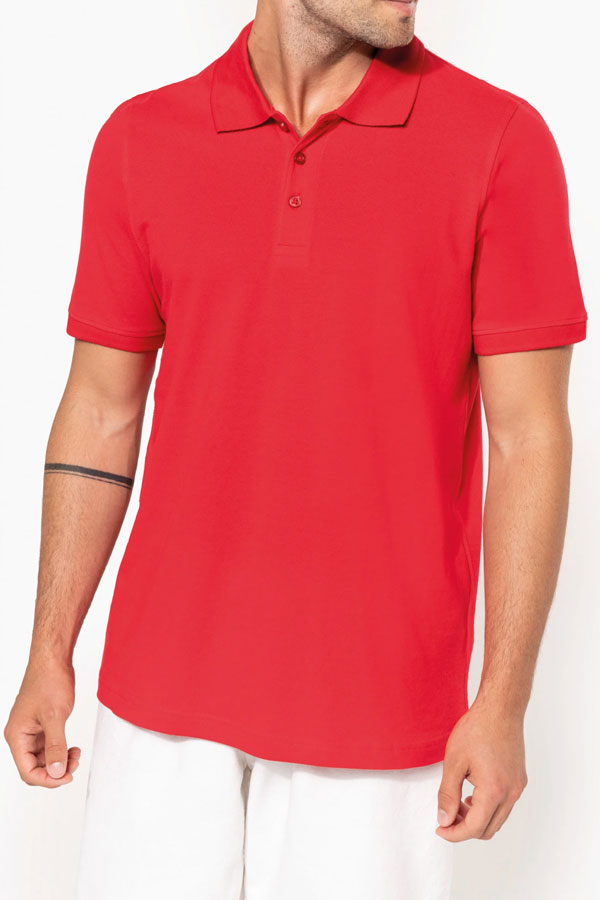
K254
Men's short-sleeved piqué polo shirt
TOP OF THE RANGE
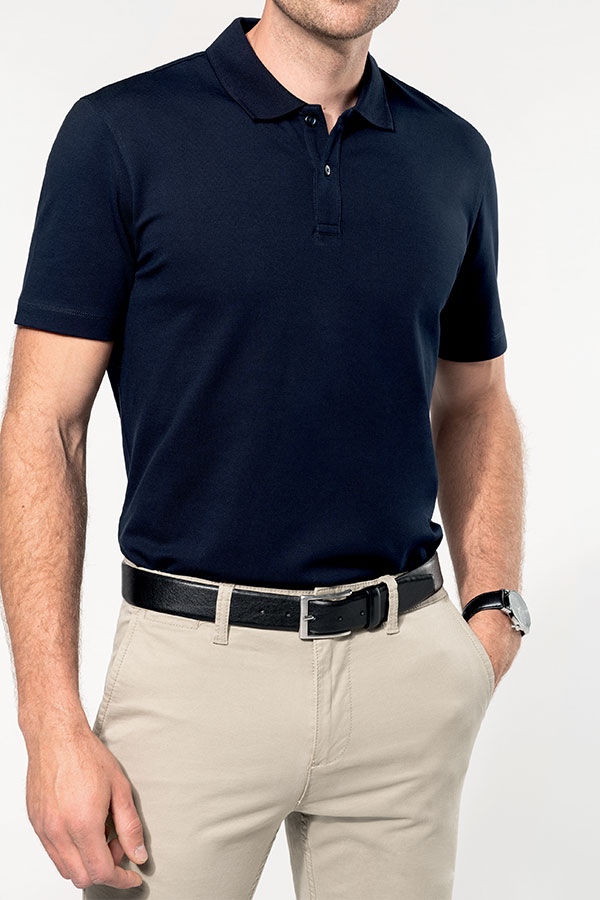
PK200
Men's short-sleeved Supima® polo shirt
SYNTHETIC
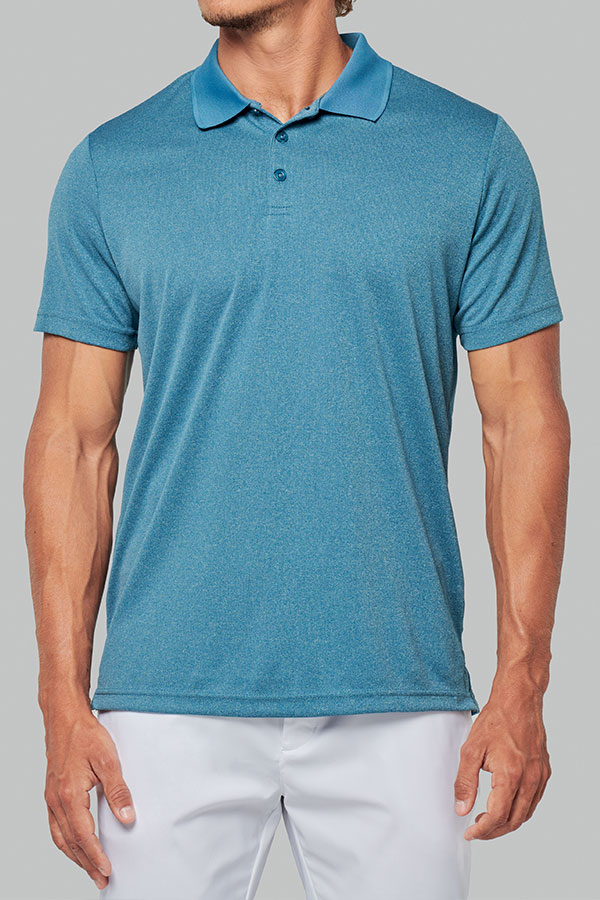
PA496
Adult short-sleeved marl polo shirt
Criteria #2:
various types of knit, yarns and their features
Knits: piqué, jersey or interlock

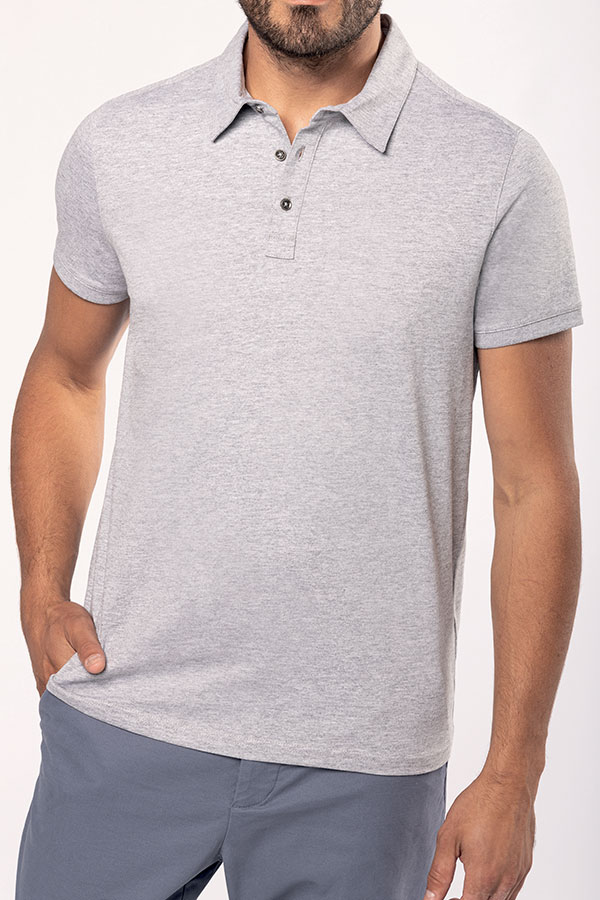
K262
Men's short sleeved jersey polo shirt
For a finish that is soft to the touch, polo shirts with a jersey knit are what you’re looking for. They are easily recognisable because the right side of the fabric is smooth while the wrong side looks like a wave with a line through it. This technique is often used to manufacture t-shirts and provides the ideal surface for all types of decoration.
When you think about polo shirts you often think about piqué knit, which looks like the fabric has been punched with a needle, formed of small patterns in diamonds, reliefs, squares or aligned dots. This type of knit gives polo shirts their iconic look, as well as being stretchy, supple and easy-care.
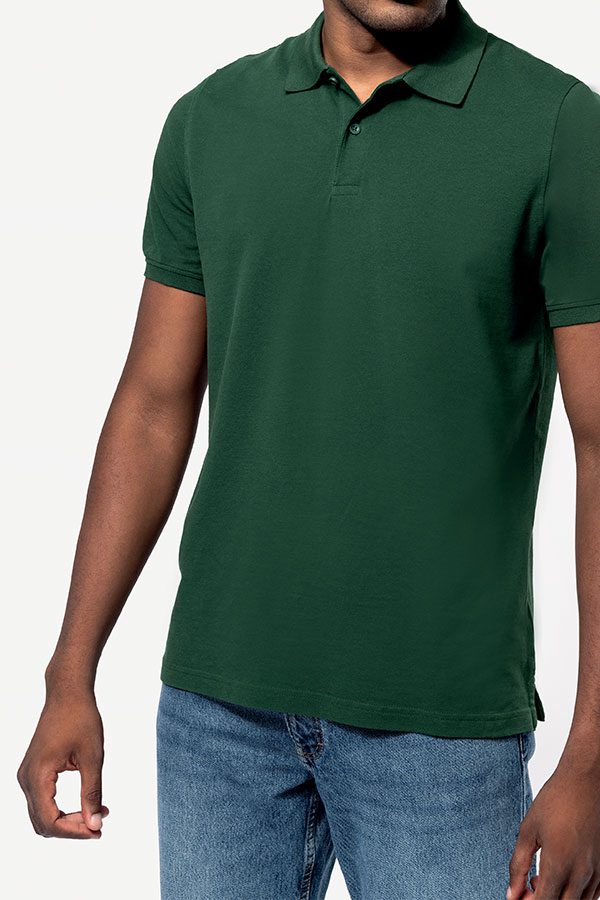
K2025
Men's Organic 180 piqué polo shirt
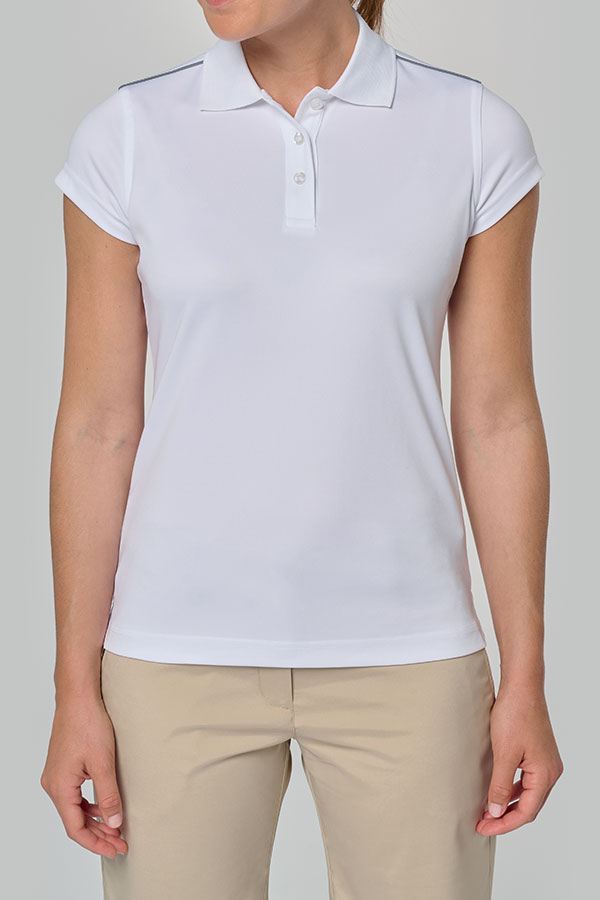
PA481
Ladies' short-sleeved polo shirt
There is also a: third type of knit: interlock knit. It consists of two rows of stitches, which combine to form a double thickness. One side is smooth, like jersey, while the other side is ribbed. Together this forms a hard-wearing fabric, thicker and heavier than piqué or jersey knits, which is naturally stretchy and does not roll up at the hem. The thickness of this type of structure also stops the textile from being see-through, even in light colourways.
The treatment of cotton fibres
We were talking earlier about cotton fibres – it’s important to know that they can be processed in several ways to adapt the finish of the fabric and make it more or less supple, soft or smooth.
For example, combed cotton: once carded (when the fibres are untangled), it is as if the cotton fibres have been “brushed”. This allows the fibres to be lengthened, while removing the shortest ones and keeping only the longest ones, a sign of a supple and comfortable fabric. This provides a better quality-price ratio than simply carded cotton. This is a great option for ensuring that promotional textiles are also comfortable!
Ringspun cotton offers another way to process the fibres. This is when the cotton used only contains long fibres, which are stretched, tightened and twisted on themselves. This process removes any roughness to create a smooth soft surface, as well as obtaining a particularly supple fabric. It can also be accompanied by a special treatment known as sanforisation that reduces textile shrinkage from machine washing as much as possible. We can then talk about pre-shrunk cotton. Ideal for personalised polo shirts that will be worn often and need to offer good freedom of movement, as well as holding their shape over time.
The TopTex selection
CARDED COTTON

K221
FRENCH RIB - LONG-SLEEVED RIBBED POLO SHIRT
COMBED COTTON

K264
Men's long sleeved jersey polo shirt
PRE-SHRUNK COMBED COTTON

K213
Rugby polo shirt
Criteria #3:
Image, finish, cut… Each range has its own combination!
As you’ve probably understood by now, polo shirts offer a relaxed but “smart casual” look that appeals to many professionals. There’s nothing surprising about that, as the polo shirt is the perfect balance between an elegant shirt for physical tasks and a t-shirt that can sometimes look too sporty and relaxed.
Polo shirts for kids, ladies, men or unisex, premium or more classical, the polo shirt comes in many guises:
Fit and shape
First of all, the cut can be slim, straight or particularly fitted, to offer a fit than ranges from tighter to looser. What it’s going to be used for will help determine the right option: closer to the body for sports or slightly looser for working outdoors in good weather (delivery operatives, waiting staff at a terrace bar, gardeners and landscapers, etc.). Please note: the iconic version of the polo shirt has short sleeves, but long sleeve versions are also available.
Finish and look
Next, when it comes to choosing the best finish, understanding the company’s positioning, trends and expectations of the end customers is key. If we take the example of ready-to-wear, the polo shirt can be sold as an indispensable basic at an affordable price and is available in a range of colours. For a slightly less classic version, there are deliberately aged versions with a more vintage look. And for companies who want to adopt a corporate polo shirt for their teams, a slim fit, combined with a smooth and supple fabric will provide a neat and serious finish.
Details
What makes a polo shirt unique? Primarily its side slits, rib neckline and placket. The rib technique is a knitted strip folded in two that provides a finish to the edges of the garment, such as at the neckline and sleeves. It is this that gives an impeccable finish to the neckline of a polo shirt, similar to that of a shirt, with a fold that keeps its shape even after washing.
As for the placket, it has two, three or even four buttons, which can be matching, metallic or sometimes even with a press fastening. A multitude of possibilities!
Positioning
If environmental impact is important in your end customer’s final decision, one of these eco-friendly styles could make the ideal solution. For example, a 100% cotton GOTS (Global Organic Textile Standard) or OCS (Organic Claim Standard) certified style will offer comfort, quality AND sustainable design!
When quality is paramount, customers tend to focus on our top of the range polo shirts. For example, it’s possible to opt for Supima® brand cotton, mentioned above, or to choose items with a more elaborate finish than the basic models. Mandarin collar, pearlised buttons, or a double taped neck: chic and elegant details that will delight customers in the hospitality and catering industry, in which image is a key part of the job.
The TopTex selection
LADIES’ SLIM FIT
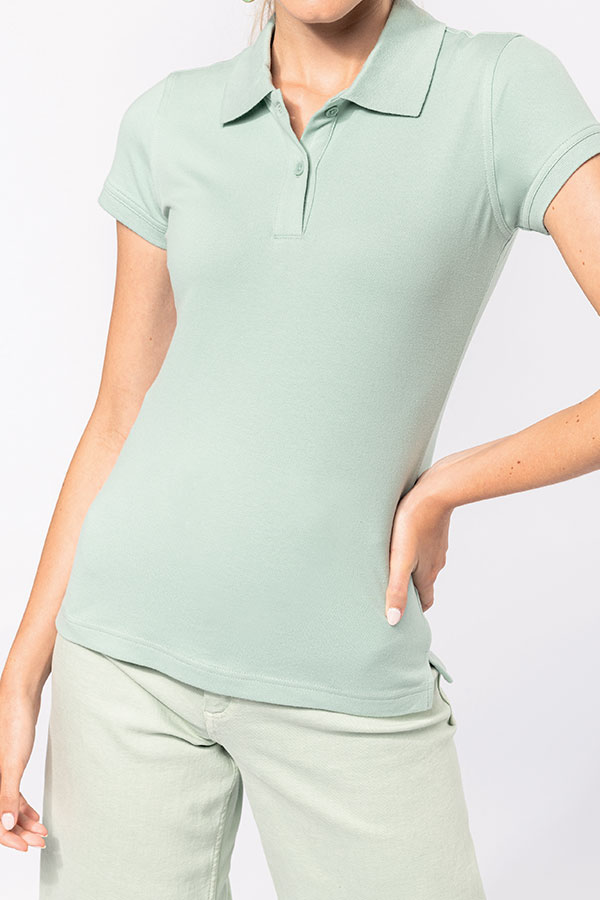
K240
Brooke - Ladies' short-sleeved polo shirt
CASUAL CHIC
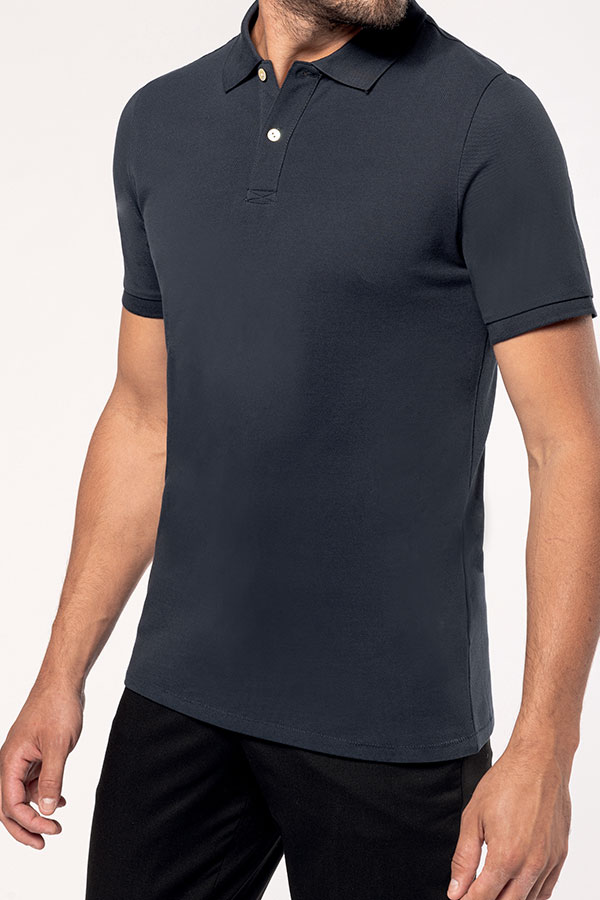
K2000
Men's Supima® short sleeve polo shirt
ECO-FRIENDLY
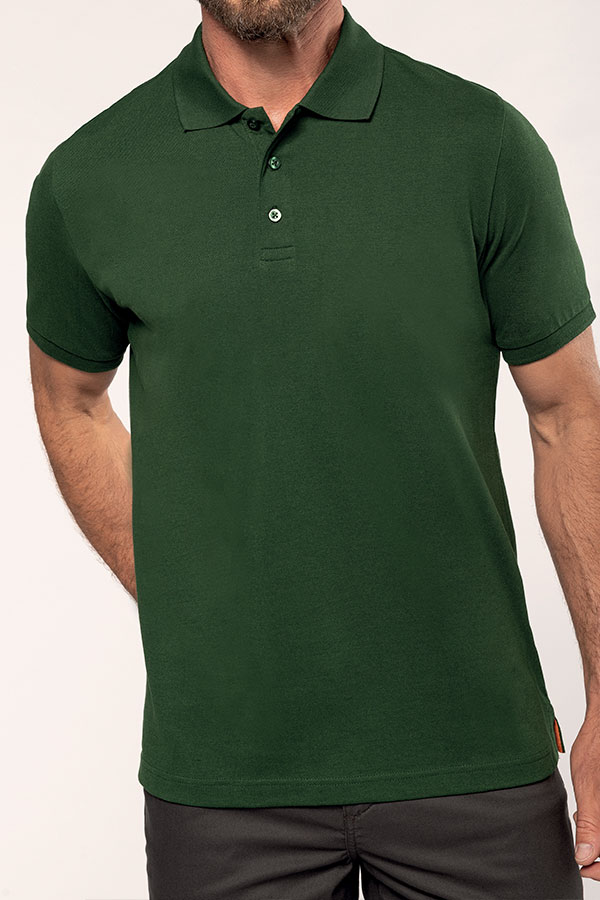
WK207
Men's eco-friendly polo shirt
Criteria #4:
match the polo shirt to the usage and care conditions

WK270
Men's short-sleeved contrasting DayToDay polo shirt
For frequent and intensive use
If the polo shirt is required to be worn very regularly, as part of physical work, it will inevitably be exposed to dirt, sweat and bad weather. This will require it to be washed often and means it needs to be particularly hard-wearing. An anti-pilling treatment and synthetic fibres are a real plus for quick drying and long-term quality, even after washing at 60°.
Similarly, polo shirts worn by athletes will be put to the test. Exposed to the sun, abrasion and perspiration, they will need to be washed after every use so that they can be used day after day! The ideal choice would be a 100% polyester polo shirt specifically designed for sports. Sometimes, they can even be treated with specific processes (CoolPlus® or QuickDry, for example). These models are extra lightweight, breathable and hard wearing, as well as particularly quick drying.
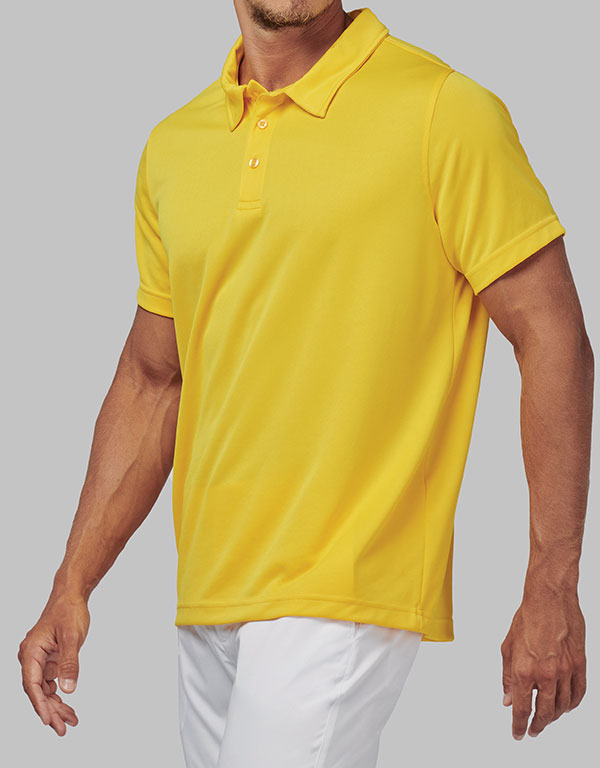
PA482
Men's short-sleeved polo shirt
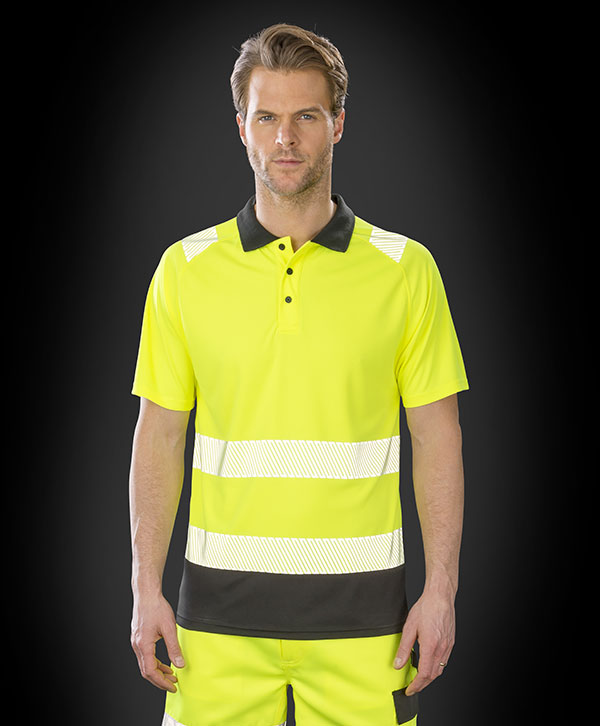
R501X
Recycled safety polo shirt
For high-visibility garments
If you know that the end users of the polo shirts are required to work in a warehouse or outside in darkness, consider a hi-vis polo shirt. These combine comfort and safety, and are often available in fluorescent yellow or orange. They are equipped with reflective strips around the body, arms and shoulders to reflect the light.
For hygienic outfits
A different scenario: for employees in the healthcare and beauty sector, in which hygiene is essential, the antibacterial and antimicrobial SilverPlus® treatment is a real step forward! Once applied to the coating of the polo shirt, this innovative process reduces odours and the presence of bacteria. It’s a real bonus when cleanliness is vital.

WK274
Men's shortsleeved polo shirt
Caring for your polo shirt
Of course, it is fundamental to comply with the conditions specified on each style. Generally speaking, machine washing is recommended over hand washing, because it allows the temperature, length and quantity of detergent used to be controlled. If in doubt, washing at 30° is less risky, with a gentle detergent and without softener to avoid damaging fibres. If the polo shirt is marked, it is advisable to wash it inside out so that the motif and colours last.
When it comes to drying, to avoid the fabric shrinking, banish the tumble dryer and dry the polo shirt in the open air. Also, to ensure that the polo shirt retains its shape, it should be hung on a hanger (preferably plastic) or on a line under the sleeves. Avoid clothes pegs at all costs as they will distort and mark the fabric.
Criteria #5:
personalised polo shirts, objectives and techniques?
Once you’ve chosen your style based on requirements, positioning and technical characteristics, it’s time to think about personalising the polo shirts.
The first step is to think about the motif or logo that will be applied to the garment. The details, size, colours and type (text, graphic visual, photograph, etc.) will determine the choice of marking technique.
At the same time, the question of budget will have an impact on the decision, especially if, for example, each polo shirt needs to be personalised with a unique design, proper to each piece. Here are a few possibilities and application examples:
- In a ready-to-wear store, in which the logo is simple, sober and elegant, embroidery is THE sophisticated choice. Are there any conditions? Sufficiently thick fabric, with a weight of at least 220g/m2 and a motif with few details for a really clean finish.
- To personalise a 100% polyester white polo shirt for a football team for example, sublimation is suitable. It allows you to apply motifs in indelible but breathable ink, which will withstand moisture and frequent washing. It’s worth remembering that it can be advantageous in terms of cost on small to medium quantities.
- Of course, screen printing is the most widely used marking technique and is highly recommended in the case of large series, for monochrome or two-tone motifs. This technique works as well on synthetic and natural fibres and is ideally suited to personalised polo shirt for a large-scale promotional event.
- If you are looking to personalise more unusual areas, such as the neck or sleeves, vinyl transfer is perfect. Unusual effects such as sequins, holograms and velvet may also be possible.
- Are expectations about the environmental impact just as important as the quality of the finish? Then DTF (Direct To Film) is the ultimate. This top-of-the range printing technique is extremely precise, on all fabrics, without the need for prior treatment. The ink used can also be ecological and biodegradable. It would be perfect for a university open day, for example. For more information about marking techniques, see our article on the subject.
To finish, one of the important points when it comes to selecting the most suitable publisher for your customer’s needs: the final branding that will be applied to the garment. In our “No Label” category, classic, premium and technical polo shirts are available without a branding label at the neck.
Only a size tag and washing instructions are provided with the polo shirt to allow the end seller to easily relabel the product with their own brand. Similarly, items listed as “Tear Away” have a detachable label.
| Cotton | Polyester | Polycotton | |
| Ease of care | + | +++ | ++ |
| Toughness and durability | +++ | ++ | +++ |
| Comfort | +++ | ++ | ++ |
| Examples of use and other details |
basic ready-to-wear eco-friendly styles |
sports and intense use technical styles |
frequent use good relationship quality-price |
You now have all the information you need to respond directly to your customers looking for marked polo shirts.
- Material, use, finish and fit: once you’ve gathered all these details, all that’s left to do is to make your choice to offer several possible options.
- Consider using the filters available on our website to do this: in the polo shirts category, choose to display only cotton polo shirts, black polo shirts or unisex polo shirts, for example.
More tips:
- To narrow down the request as much as possible, try to work together to decide on the total budget, quantities and sizes to be ordered.
- Restocking is also important, particularly for a company that brings in new employees in need of outfits, or a fashion store that needs to freshen up its stock.
- Finally, last but not least, don’t overlook timings!. For events in particular, the order needs to be available for a specific date so planning ahead is essential.
If your request is unusual and you need help or more information about our products our advisers are there to help you!



